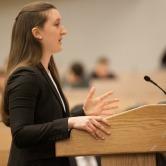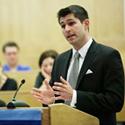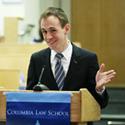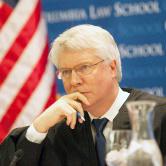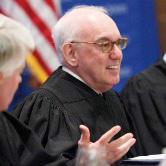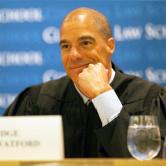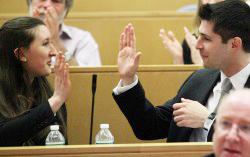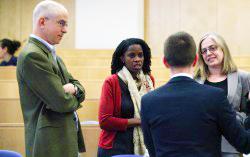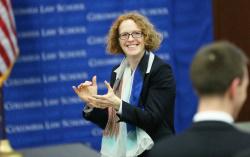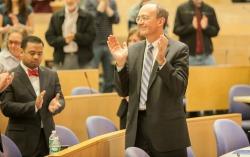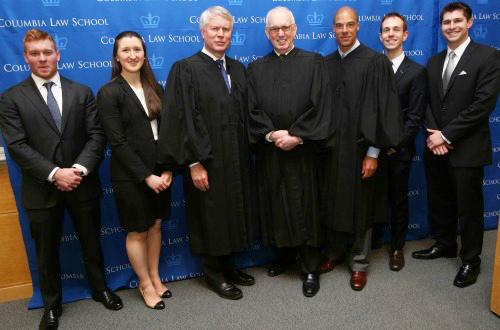Justin DiGennaro '15 Awarded Best Oralist at Paul, Weiss Harlan Fiske Stone Moot Court Finals
Four Students Present Arguments Before U.S. Court of Appeals Judges Robert D. Sack '63, David F. Hamilton, and Paul J. Watford
New York, April 23, 2015—Four Columbia Law School students put their appellate skills to the test before a panel of U.S. Court of Appeals judges, addressing complicated questions dealing with housing discrimination, administrative law, and constitutional standing requirements at the Paul, Weiss Harlan Fiske Stone Moot Court Competition at Columbia Law School on April 16.
This year marked the 90th anniversary of the competition, and Justin DiGennaro ’15 came away with the Lawrence S. Greenbaum Prize for best oralist based on his arguments and responses to the judges’ questioning. The award, established in 1951 and named after a member of the class of 1912, is presented each year to the student who delivers the best oral presentation in the prestigious appellate advocacy competition. DiGennaro was joined by three fierce competitors—Elizabeth Cruikshank ’15, Peter Fountain ’15, and Eric Konopka ’15—who earned the chance to argue before the distinguished judges, as well as a room full of students, faculty members, friends, and family. Cruikshank was recognized for writing the best final-round brief.
| (from left) Elizabeth Cruikshank ’15, Justin DiGennaro ’15, Peter Fountain ’15, and Eric Konopka ’15 compete in front of a panel of federal judges in the final round of the Paul, Weiss Harlan Fiske Stone Moot Court competition. |
Judge Robert D. Sack ’63 of the U.S. Court of Appeals for the 2nd Circuit praised each of the competitors.
“You did a masterly job,” he said, adding wryly: “You don’t know what it’s like being a judge on a moot court. When you leave the room to deliberate, you hear lots of applause—and you know it’s not for you.”
Sack was joined on the bench by Judge David F. Hamilton of the U.S. Court of Appeals for the 7th Circuit, and Judge Paul J. Watford of the U.S. Court of Appeals for the 9th Circuit.
| U.S. Court of Appeals Judges (from left) David F. Hamilton, Robert D. Sack ’63, and Paul J. Watford tested the students' appellate advocacy skills with probing questions on the laws at issue in the case. |
“We were fortunate to have such a wonderful panel,” said Philip M. Genty, the Everett B. Birch Innovative Teaching Clinical Professor in Professional Responsibility, who oversees the Law School’s Moot Court Program. “They engaged the students in a challenging way, asking probing and sometimes unexpected questions and pushing the students to think more deeply about the implications of their arguments. The judges did this in a constructive way; their goal was clearly to educate the students—and everyone in the audience—about the issues in the case and appellate advocacy more generally. The students handled this with poise and intelligence, displaying an impressive level of preparation and intellectual agility. In addition, each student had developed her or his individual style and used this effectively.”
An Engaged Bench
The Harlan Fiske Stone Moot Court final arguments, part of the Paul, Weiss, Rifkind, Wharton & Garrison Moot Court Program, are the culmination of a three-round elimination tournament in appellate advocacy. A total of 42 students entered the competition in the fall, with 16 battling it out in the spring semifinal round.
The fictional case was written by student director Kenneth T. Hagan ’15 and touched on timely social issues, including affordable housing and immigration, while also raising interesting legal questions about standing and disparate impact. The imaginary plaintiff, Ned Stark, was a naturalized U.S. citizen from Guatemala looking to move with his wife and five children (whose names and towns are all derived from HBO’s popular show Game of Thrones) into an affordable housing unit in the Village of Casterly Rock, a wealthy suburban town. When he found out the unit he was interested in was covered by a village code giving priority to the relatives of current town residents, Stark filed suit on the advice of Westerlands Intercounty Center for Housing (WICH), a nonprofit organization that promotes fair housing for racial and ethnic minorities. He was eventually awarded $1 million in damages.
Cruikshank and DiGennaro argued on behalf of the village, while Konopka and Fountain represented Stark and WICH.
The judges didn’t go easy on the future attorneys standing before them, but they still found a way to lighten the proceedings, peppering their rapid-fire questioning with jokes and good-natured teasing. The students responded in kind.
Hamilton asked Fountain if the judges could fashion a remedy that would benefit future housing applicants but not Stark. Fountain conceded that they could.
“Our overall goal here is justice—even if that means Ned Stark doesn’t end up with a home,” Fountain said.
When asked if he was abandoning his client’s interest, he answered, “This is sort of a one-off,” prompting laughter throughout the crowd. “I’m not sure I’ll be representing Ned Stark again.”
| (from left) Cruikshank and DiGennaro congratulate each other on their wins, and Professors Daniel C. Richman, Olatunde Johnson, and Gillian E. Metzger '96 talk with Konopka after the competition. |
|
Gillian Lester, Dean and the Lucy G. Moses Professor of Law, left, Harlan Fiske Stone Moot Court Director Kenneth T. Hagan '15 (in bow tie) and Philip M. Genty, the Everett B. Birch Innovative Teaching Clinical Professor in Professional Responsibility, applaud the students' performance after the competition.
Genty oversees the Law School’s Moot Court Program.
|
A Case with a Personal Touch
Hagan, whose mother is Filipina and whose father is Irish, said he came up with the idea for the case based on demographic factors in his hometown of Garden City, New York. He sought guidance from Professors Olatunde Johnson and Gillian E. Metzger ’96 and from lecturer Diane L. Houk, of counsel at Emery Celli Brinckerhoff & Abady.
“The intersection of socioeconomic status and race is a murky area,” he said. “Is there a correlative relationship between the two? Is it because of market forces and coincidence that some wealthy towns are predominantly white, or are wealth and status the result of a race-driven agenda? I decided to put a lens on that issue with this problem.”
In Preparation for Success
After the competition, best-brief winner Cruikshank said she thought the law was on her side.
“I really thought I had the stronger case legally,” she said, adding that she tried to avoid using too much legalese in her brief. “Articulating the law without getting bogged down in the weeds is really important in all legal writing.”
Lawrence S. Greenbaum prizewinner DiGennaro had an added challenge for the final round: He had argued the other side of the case in the semis.
“In the end, I think it was a blessing,” he said. “I had engaged with the ideas from the opposing side, so I knew what their strengths and weaknesses were and was able to incorporate them into my brief and argument.”
Both prize winners had different ways of preparing for the final round of competition. Cruikshank—on the advice of Professor Daniel C. Richman—practiced her argument in front of the mirror. DiGennaro went through the questions he anticipated getting from the bench while going about daily life in his apartment.
“My fiancée would hear me in the shower saying, ‘Yes, Judge Watford, but the reason for that is…’” he laughed.
Both Cruikshank and DiGennaro are passionate about being litigators, a quality Sack said was necessary to be successful.
“If you don’t want to be up there, I guarantee you the person on the other side does,” he said.
| After the competition, the Paul, Weiss Harlan Fiske Stone Moot Court finalists and judges posed for a picture before enjoying a reception with Columbia Law School students, faculty, and friends and family members. |
The annual competition’s namesake, Harlan Fiske Stone, was dean of the Law School from 1910 until 1924 when President Calvin Coolidge appointed him U.S. attorney general. Stone was appointed to the U.S. Supreme Court the following year and became chief justice in 1941.
Members of the 2015 moot court executive committee are Hagan, director of the Harlan Fiske Stone Honors Moot Court; Alex Reid ’15, executive director of the Moot Court Program; Devon Klein ’15, director of the First-Year Foundation Moot Court Program; and Shannon Cleary ’15, director of the External Moot Court Programs.
The Harlan Fiske Stone Moot Court Competition is made possible by the generous support of Paul, Weiss, Rifkind, Wharton & Garrison.
